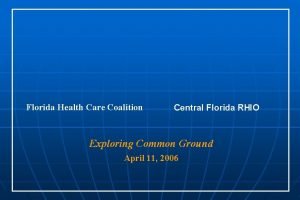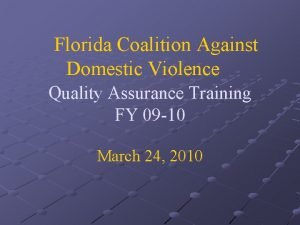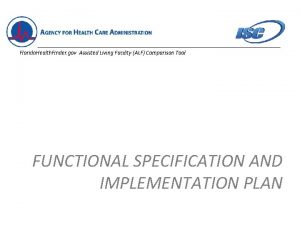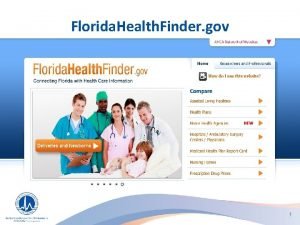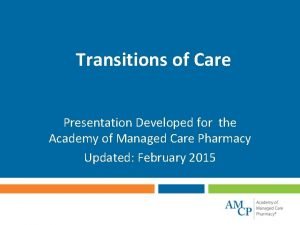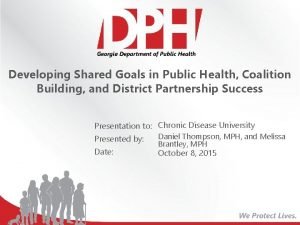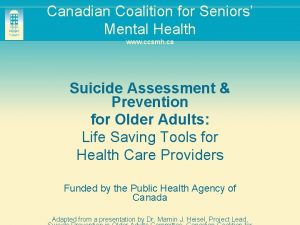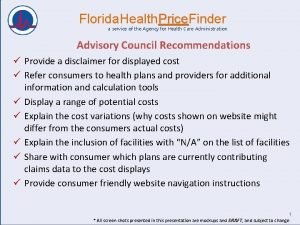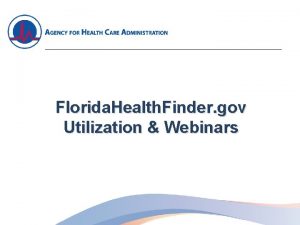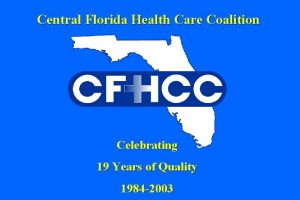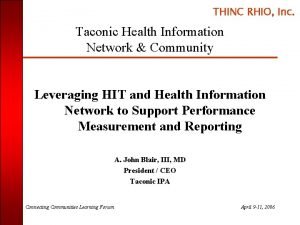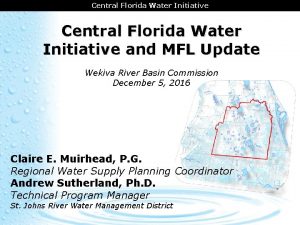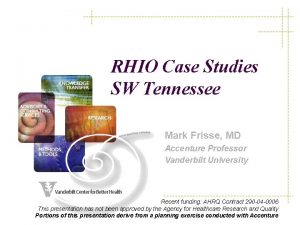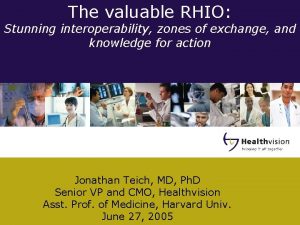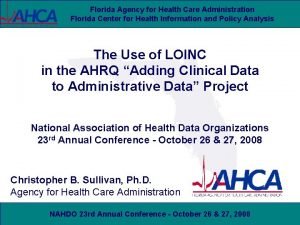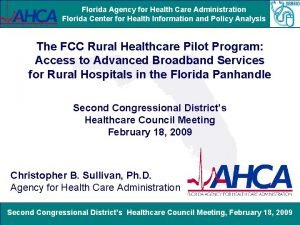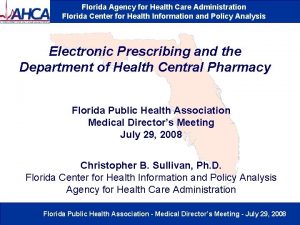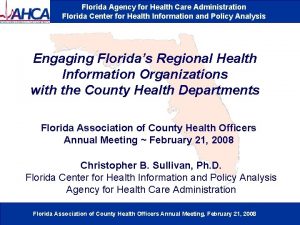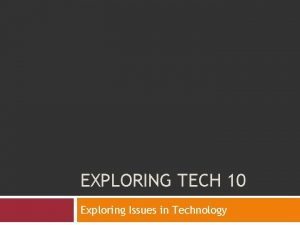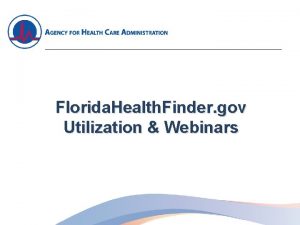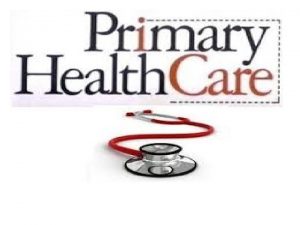Florida Health Care Coalition Central Florida RHIO Exploring
























- Slides: 24

Florida Health Care Coalition Central Florida RHIO Exploring Common Ground April 11, 2006

Florida Health Care Coalition

Central Florida RHIO Service Area • • Orange Seminole Osceola Polk Brevard Lake Volusia

Central Florida RHIO Governance • • 501(c)(3) – most likely Studies recommend neutral third party convener (FHCC) • Chair: Becky Cherney, Florida Health Care Coalition • Co-Chair: Rick Schooler, Orlando Regional Healthcare

Central Florida RHIO Governance (cont. ) • Committees Ø Clinical – Ø Chair: Phil Chen, MD, Ph. D (Cognoscenti Health Institute) Ø Vice Chair: Robert Westergan, MD, MBA (Jewett Orthopeadic Clinic) Ø Technology – Ø Chair: Rick Schooler, FACHE, MBA (Orlando Regional Healthcare) Ø Vice Chair: Eddie Soler, (Florida Hospital) Ø Legal – Ø Chair: Greg Chaires, Esq. (Webster, Chaires & Partners) Ø Vice Chair: Michael Lowe, BS, MBA, JD (Ruden Mc. Closky)

Central Florida RHIO Governance (cont. ) • Committees Ø Financial – Ø Chair: Becky Cherney (FHCC) Ø Vice Chair: Andrew Crooks (CIGNA Health. Care) Ø Research & Communication – Ø Chair – Research: Karen Van Caulil, Ph. D (District VII Health Planning Council) Ø Chair – Communication: Lisa Portelli (Winter Park Health Foundation) Ø Vice Chair: George Ellis, MD (PCAN and Orange County Medical Society)

Central Florida RHIO Finance (July 2006 / 2007 / 2008) • Planning Grants • Employers & Foundations • Grants • Health Plans • Pharma and others $300, 000 $1, 500, 000 $1, 250, 000 $500, 000 $4, 050, 000


Central Florida RHIO

Charges of Clinical Committee n Defining and prioritizing RHIO functionalities • To determine basic clinical dataset requirement • To identify appropriate clinical functionalities that would benefit RHIO stakeholders (i. e. , patients, providers, payers, employers, public health efforts, etc. ) n Serving as liaisons to providers to: • promote RHIO adoption • identify and match provider needs with support resources for launching RHIO in the community n Peer group communication

“Realistic” clinical dataset requirements n n n Primary priority – relatively centralized data source with high objectivity: hospital inpatient records, outpatient laboratory and pharmacy data Secondary priority – highly desirable information but lack standardized input criteria, format and source identification: Drug Allergy Tertiary priority – desirable information but standards for source reliability, practical, adoptable input methods must be developed prior to data collection: Immunization Record, Past Medical History of sentinel illness, Surgical history

“Unwanted” clinical dataset n ICD-9 coding system used for claims is NOT reliable and may introduce liability to RHIO and providers who receive the information

Value Demonstration Projects n n n To demonstrate how data access and connectivity can improve patient outcome To demonstrate how RHIO can promote evidencebased and best practices To demonstrate data access can improve efficiency and identify those stakeholders who benefit financially To provide tangible examples to educate and gain support of patients and providers To provide functionality prototypes To identify potential implementation barriers Use existing “islands of connectivity” in the community Da ta Av ail ab ilit y

Diabetic Complications n Amputations • $484, 407 • 7 @ $69, 201 n Heart Disease • $9, 939, 534 • 414 @ $24, 009 n Chronic Renal Failure • $2, 279, 406 • 78 @ $29, 223 n Catastrophic cases • $1, 124, 127 • 9 @ $124, 903 per case

Project #1: Diabetes Management for the Uninsured n n Purpose of the project is to improve diabetes management in uninsured patients “Islands of connectivity” and data sharing established between CFFHC, Cognoscenti, FHHS and Trajectory Limited clinical data are used in disease management and outcome evaluation Clinical benchmarks will be established for uninsured vs. insured, public funded vs. private clinics

Project #1: Diabetes Management for the Uninsured RHIO’s role n n n Assist in evaluations of clinical outcome Assist in evaluations of cost efficiency and ROI Identify stakeholder beneficiaries Use beneficiary data to raise funding for RHIO and develop appropriate user fees for “non-typical” providers (e. g. , Disease Management vendors, payers) Consider incorporating limited clinical dataset into RHIO CCR database

Project #2: Laboratory Utilization Management n n n One large insurance company’s claims data revealed that FL laboratory utilization is 270% of national average “Islands of connectivity” and data sharing established between laboratory, providers and payer to conduct utilization review, intervention implementation and project evaluation RHIO’s roles……

Electronic O/E intervention

Electronic O/E intervention

Peer comparison Clients: XXXXXXX Clients: YYYYYYY From 10/01/200512/31/2005 TOTAL TEST COUNT From: 10/01/200512/31/2006 Test Code Description Total Test Count 10 COMP METABOLIC PANEL 1378 Test Code Description 1000 COMPLETE BLOOD COUNT 425 14 LIPID PANEL 1268 14 LIPID PANEL 422 1000 COMPLETE BLOOD COUNT 1139 10 COMP METABOLIC PANEL 418 808 TSH 930 17 TSH W/REFLEX TO FREE T-4 390 4 URINALYSIS 585 1520 RPR, SYPHILIS SCREEN 338 317 HEMOGLOBIN A 1 C 534 4 URINALYSIS 299 71 O THIN PREP, OSCEOLA PATH 284 317 HEMOGLOBIN A 1 C 163 1514 H PYLORI AB, Ig. G 183 833 CANCER ANTIGEN 125 155 805 T-4 (THYROXINE) 139 813 C-REACTIVE PROTEIN, HIGH 150 854 MICROALBUMIN, URINE 129 56 CHLAMYDIA/GC DNA PROBE 128 71 THIN PREP, PAP 91 324 MAGNESIUM 115 1026 SEDIMENTATION RATE 90 835 PSA 85 1406 CULTURE, URINE 84 325 GLUCOSE, SERUM 65 322 LDL, DIRECT 84 71 R THIN PREP R/ HI RISK HPV 50 835 PSA 78 71 THIN PREP, PAP 50 12 HEPATIC FUNCTION PANEL 56 853 MICROALBUMIN/CREAT RATIO 42 856 RHEUMATOID FACTOR 54 12 HEPATIC FUNCTION PANEL 39 1024 PROTHROMBIN TIME 50 1024 PROTHROMBIN TIME 37 851 LEAD 45 1527 HIV Ab w/Reflex West. Blot 36 930 HELICOBACTER PYLORI Ag 43 5 URINALYSIS SCREENING 35 1526 ANTI-NUCLEAR ANTIBODIES 42 803 T-4, FREE 33 853 MICROALBUMIN/CREAT RATIO 35 1026 SEDIMENTATION RATE 32 993 ALLERGEN, FOOD PROFILE 19 35 75 HPV, THIN PREP 21 994 ALLERGEN, INHALANTS 35

Monitoring Current Guidelines CA 125 • • • n n n = 191, > 16. 3 = 19 (10%) The positive predictive value for CA-125 is very low (1. 6%); significant potential harms (increased anxiety, 3 -4% and unnecessary surgery 0. 2 -0. 7%) have been documented Recommendations: USPSTF, NIH/NCI, ACS, ACOG, CTFPHC currently recommend against screening for ovarian cancer in non-high risk or asymptomatic women For symptomatic or high risk patients (abdominal/pelvic pain, unexplained weight loss, PMH of ovarian, breast and colon cancer, and positive family history of ovarian cancer), ACOG suggests pelvic exam, CA-125 and ultrasound evaluations.

Regional community surveillance H. pylori • • n n n n = 23, negative = 7 (30%), unequivocal = 0, positive = 16 (70%) There is a high prevalence of H. pylori infection in Central and South Florida 38% in Hispanics, 45% in African Americans, 28% in Caucasians in an employer-based screening event in South Florida 9% in Seniors in a Central Florida screening event 60% in Hispanics in a community event in Central Florida Recommendations: Increase awareness for employees Increase symptomatic screening Consider broader screening with intention to treat

Hmmm. . . “When your head is in the refrigerator and your butt is in the oven, the average looks good but you don’t feel very well!

Questions? Becky J. Cherney President/CEO Florida Health Care Coalition 4401 Vineland Road, Suite A 10 Orlando, FL 32811 407 -425 -9500 becky@flhcc. com
 Florida health care coalition
Florida health care coalition University of central florida health care administration
University of central florida health care administration Florida coalition against domestic violence
Florida coalition against domestic violence Fredericksburg housing coalition
Fredericksburg housing coalition Florida facility finder
Florida facility finder Florida healthfinder
Florida healthfinder National transitions of care coalition
National transitions of care coalition Global health technologies coalition
Global health technologies coalition Coalition building public health
Coalition building public health Checkmite active ingredient
Checkmite active ingredient Minnesota soil health coalition
Minnesota soil health coalition Global business coalition for health
Global business coalition for health Canadian coalition for seniors mental health
Canadian coalition for seniors mental health Primary secondary tertiary care nursing
Primary secondary tertiary care nursing Health and social care values unit 2
Health and social care values unit 2 Health and social care component 3
Health and social care component 3 Jain society of central florida
Jain society of central florida Biographical page of passport india
Biographical page of passport india Bsa central florida council
Bsa central florida council Florida kid care
Florida kid care Florida health price finder
Florida health price finder Facsimile finder
Facsimile finder Decadence synonym
Decadence synonym Flyte hearing aid reviews
Flyte hearing aid reviews Navajo nation breastfeeding coalition
Navajo nation breastfeeding coalition
